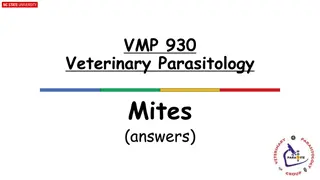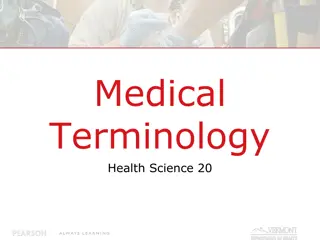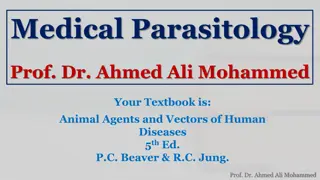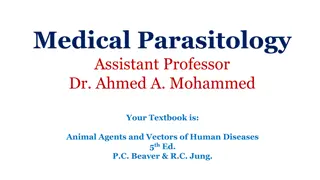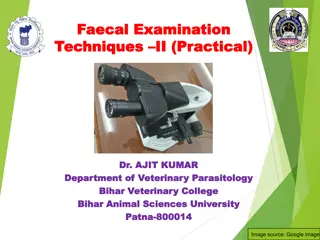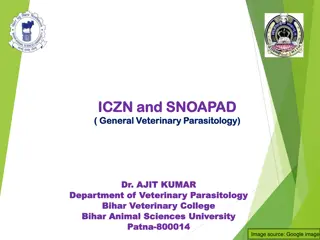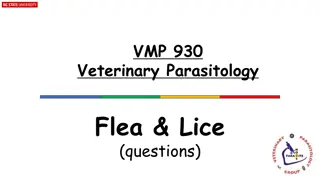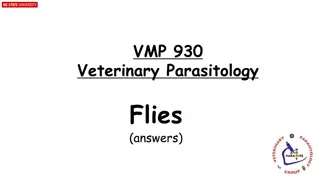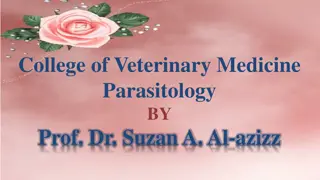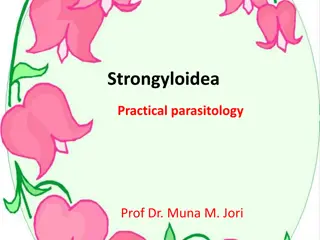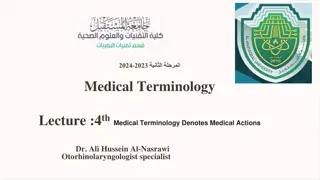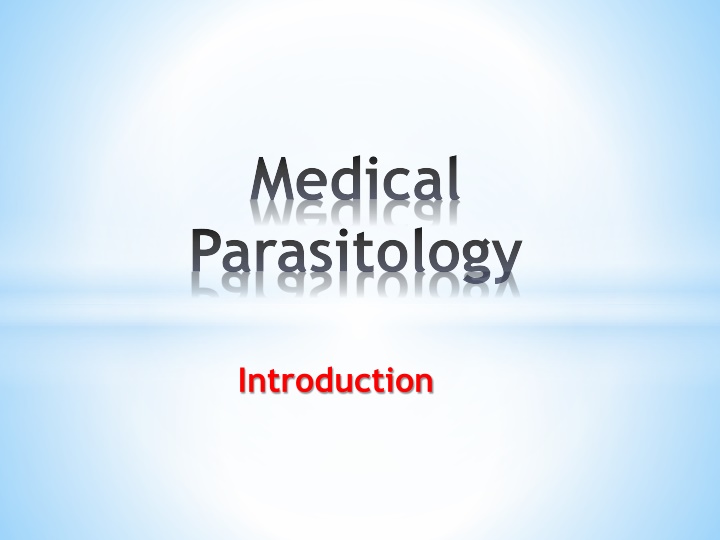
Medical Parasitology: Types, Transmission, and Classification
Explore the fundamentals of medical parasitology, including types of parasites, host classifications, modes of transmission, and taxonomy. Learn about different stages of infection, reservoir hosts, vectors, and common sources of infection. Delve into the classification of various genera and the importance of handling specimens safely to avoid potential infections.
Uploaded on | 1 Views
Download Presentation

Please find below an Image/Link to download the presentation.
The content on the website is provided AS IS for your information and personal use only. It may not be sold, licensed, or shared on other websites without obtaining consent from the author. If you encounter any issues during the download, it is possible that the publisher has removed the file from their server.
You are allowed to download the files provided on this website for personal or commercial use, subject to the condition that they are used lawfully. All files are the property of their respective owners.
The content on the website is provided AS IS for your information and personal use only. It may not be sold, licensed, or shared on other websites without obtaining consent from the author.
E N D
Presentation Transcript
Medical Parasitology Introduction
1- Parasite Types of parasites: Obligatory parasite Facultative parasite Accidental parasite 2- Host Types of hosts: Definitive host Intermediate host Definitions:
3- Life cycle 4- Parasitic infection 5- Parasitic disease 6- Parasitic infestation 7- Habitat 8- Commensalism 9- Symbiosis 10- Reservoir host 11- Vector: mechanical vector or biologic vector
12- carrier 13- Zoonosis 14- Infective stage 15- Diagnostic stage 16- Protozoa 17- Eukaryote
1- Soil 2- Water 3- Food 4- Insect vector 5- Animals 6- Other persons 7- Self Sources of infection
1- Oral transmission 2- Skin transmission 3- Vector transmission 4- Direct transmission Modes of infection
EXAMPLE GENUS CLASSIFICATION NAME Kingdom Subkingdom Phylum Subphylum Sarcodina Subphylum Mastigophora Animalia Protozoa Sarcomastigophora Entamoeba Giardia Plasmodium (malaria) Balantidium Enterocytozoan (microsporidium) Phylum Apicomplexa Phylum Ciliophora Phylum Microspora Taxonomy
CLASSIFICATION NAME Kingdom Subkingdom EXAMPLE GENUS Ancylostoma (hookworm) Animalia Metazoa Phylum Nematoda Phylum Class Class Platyhelminthes Cestoidea Trematoda Taenia (tapeworm) Fasciola (liver fluke) Anopheles (malaria vector mosquito) Phylum Arthropoda
1- Delivery: 2- Safety: All fresh specimens should be handled carefully, since represents a potential infection. each specimen source of 3- Number of specimens: Collection of the specimens:
4- Collection time: 5- Specimen type and stability: Liquid specimens: Soft (semi-formed) specimens Formed specimens
Aim: 1- To preserve protozoan morphology. 2- To prevent the continued development of some helminthic eggs and larvae. The most common preservative used is 10% formalin. Preservation of stool specimens:
1- Scanty infection. 2- Tissue parasite having no portal of exit (Hydatid disease) 3- Migratory stage:(Fasciola) 4- Chronic infection:fibrosis (Bilharziasis) INDIRECT IMMUNOLOGICAL METHODS
1.Indirect Haemagglutination Test (IHA) 2.Indirect Fluorescent Antibody Test (IFA) 3.Enzyme linked Immunosorbant Assay (ELISA) 4.Complement fixation test (CFT) 5.Agar gel Immunodiffusion (AGID) 6.Immunodiagnostic strip tests (Dip stick test) The commonly used tests are:
Phylum Sarcomastigophora: Subphylum Mastigophora Subphylum - Sarcodina Phylum Apicomplexa Phylum Ciliophora Phylum Microspora Subkingdom Protozoa
Phylum Nematoda Phylum Platyhelminthes: Class Trematoda Class Cestoidea Subkingdom - Metazoa
1-Asexual reproduction: Binary fission: Multiple fission: 2- Sexual reproduction: Union of two gametes following reduction division. Division (reproduction):

